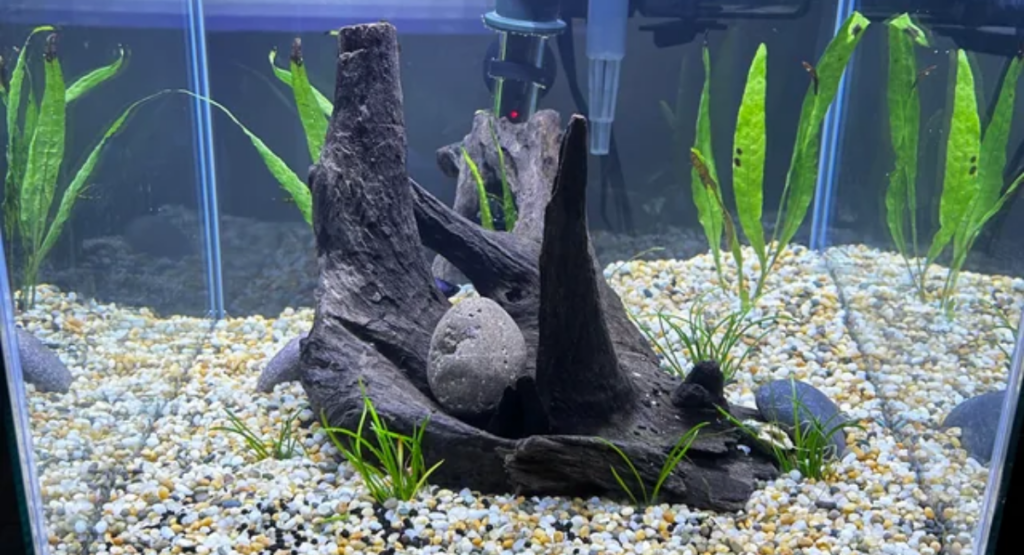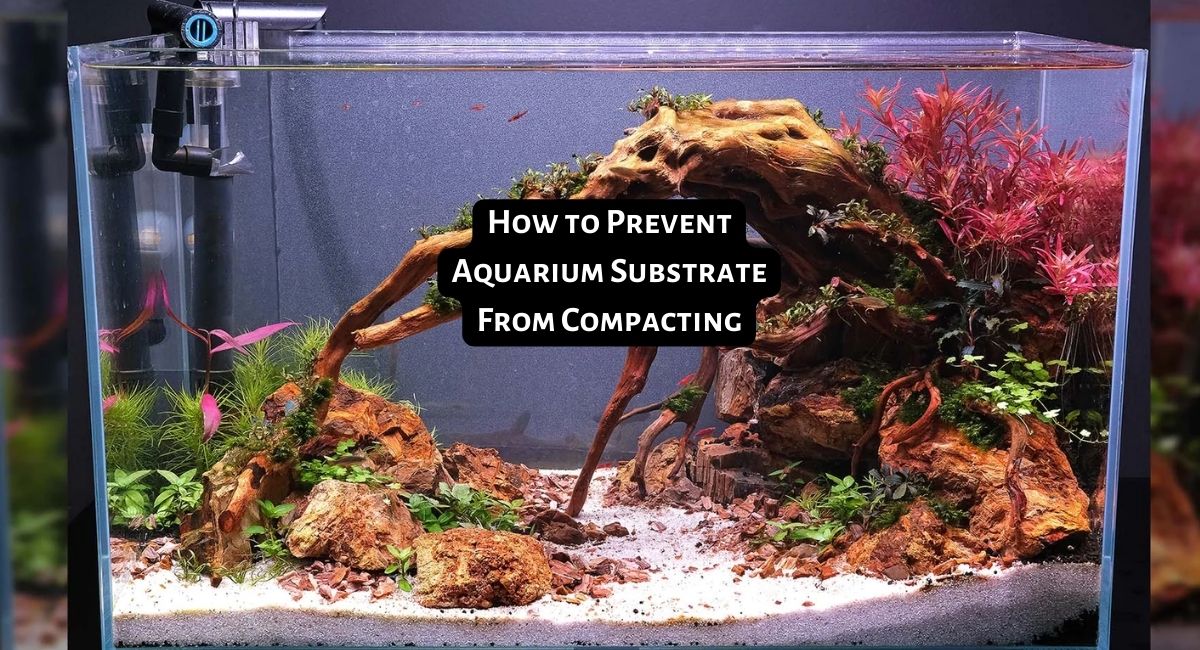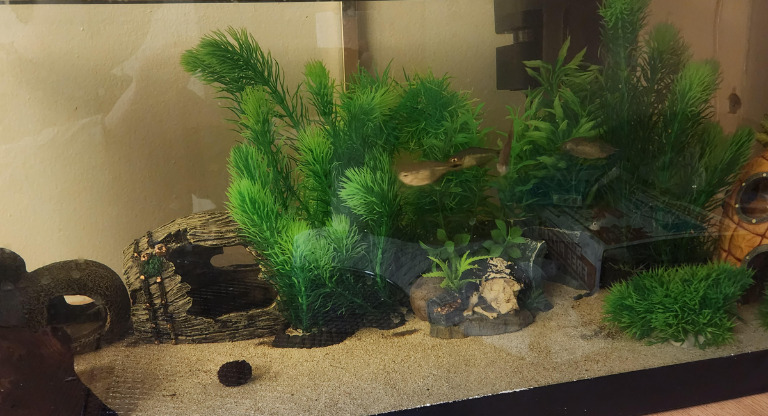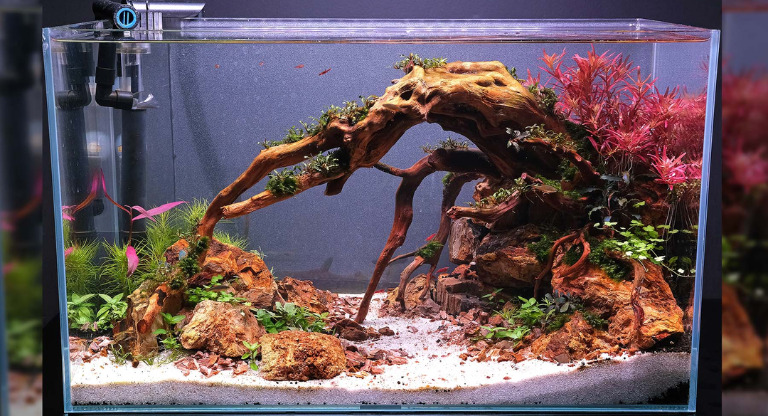Smartplantedaquarium.com participates in affiliate marketing programs. We may earn commissions on purchases made through our affiliate links. This doesn't affect our content or recommendations and we only recommend products we would put in our own tanks.
If you’re an aquarium enthusiast, then you know all too well the problems associated with compaction of aquarium substrate. Compaction is a serious issue that can lead to poor water circulation, toxic buildup, and reduced plant growth.
It’s important to take steps to prevent compaction from occurring in your tank so that your fish, plants, and other aquatic creatures remain healthy and happy. In this blog post, I’ll share some tips on how to prevent aquarium substrate from compacting and provide advice on how to maintain proper aquarium maintenance practices.
By following these simple guidelines, you can ensure that your tank stays healthy and provides a safe environment for all its inhabitants.
Contents
- Key Takeaways
- Signs of Substrate Compaction
- Why Does Aquarium Substrate Compact
- How to Prevent Aquarium Substrate From Compacting
- How to Prevent Substrate Compaction With Natural Methods
- How to Fix Substrate Compaction if It Already Exists in the Aquarium
- Can Mixing Substrates Prevent Compaction
- How Often Should I Check Substrate for Compaction
- Conclusion
- Frequently Asked Questions
Key Takeaways
- Substrate compaction in an aquarium can lead to poor water circulation, toxic buildup, and reduced plant growth.
- Signs of substrate compaction include poor water circulation, accumulation of debris and waste, anaerobic pockets, unhealthy plant growth, difficulty in plant propagation, algae overgrowth, and uneven substrate surface.
- Aquarium substrate can compact due to biological activity, water flow, plant roots, waste accumulation, gravitational forces, and lack of substrate maintenance.
- To prevent substrate compaction, choose a substrate with larger particles, use porous materials or substrate additives to improve water flow, employ aeration devices, incorporate burrowing-friendly species, perform regular substrate maintenance, use live plants and plant roots, avoid overstocking, conduct regular water changes, and use a substrate rake.
- Natural methods to prevent substrate compaction include adding burrowing species, bottom-dwelling fish, snails, rooting and burrowing plants, avoiding excessive disturbance, using proper planting techniques, allowing natural decay and detritus, and balancing fish stocking.
- To fix substrate compaction, gently stir the substrate, use a substrate vacuum to remove debris and waste, and consider replacing or mixing substrates if necessary.
Signs of Substrate Compaction
Identifying signs of substrate compaction in an aquarium is crucial for maintaining a healthy and balanced aquatic environment. Here are some common signs that may indicate substrate compaction:
- Poor water circulation: If you notice reduced or stagnant water flow in certain areas of the aquarium, it could be a sign of substrate compaction. Compacted substrate can impede water movement through the substrate layers, leading to low oxygen levels and the accumulation of waste.
- Accumulation of debris and waste: Excessive substrate compaction can trap debris, uneaten food, and fish waste, causing them to build up in the substrate. This can lead to deteriorating water quality, foul odors, and potential ammonia spikes, impacting the overall health of the aquarium inhabitants.
- Anaerobic pockets: Anaerobic conditions can develop in compacted areas of the substrate, leading to the production of toxic compounds like hydrogen sulfide. If you notice a strong, rotten egg-like odor coming from the substrate, it may indicate the presence of anaerobic zones.
- Unhealthy plant growth: Plants may show signs of distress in compacted substrates. Roots may struggle to penetrate the dense substrate, leading to weak or stunted plant growth. Some plants might show yellowing leaves or exhibit signs of nutrient deficiency due to restricted nutrient uptake.
- Difficulty in plant propagation: If you have live plants in the aquarium, propagating them through runners or offshoots may become challenging in compacted substrates. The dense substrate can hinder new plant growth and limit the spread of runners.
- Algae overgrowth: Substrate compaction can disrupt the balance of nutrients in the aquarium. This can result in excess nutrients like nitrogen and phosphorus, leading to algae overgrowth on the substrate and other surfaces.
- Uneven or bumpy substrate surface: In heavily compacted areas, the substrate may become uneven or bumpy due to the shifting and settling of particles over time.
Why Does Aquarium Substrate Compact
Aquarium substrate compacts primarily due to the combined effects of various factors related to the activities of aquarium inhabitants and natural processes. Some of the key reasons why aquarium substrate compacts include:
Biological activity: Fish and other aquarium inhabitants, including snails and shrimp, are constantly moving, burrowing, and digging in the substrate. Their activities disturb and shift the substrate particles, causing them to settle and pack more densely over time.
Water flow: Water circulation and filtration systems in the aquarium can create currents that move the substrate particles. Over time, these currents can lead to the gradual settling and compaction of the substrate.
Plant roots: In a planted aquarium, aquatic plants root into the substrate to anchor themselves and absorb nutrients. As plants grow and their root systems expand, they can displace and compress the substrate particles.
Waste accumulation: Uneaten food, fish waste, and organic debris accumulate in the substrate over time. As these materials decompose, they can release gases, contributing to substrate compaction.
Gravitational forces: The weight of the substrate itself, along with the weight of the water and aquarium decor, can exert pressure on the lower layers of the substrate, causing them to compact.
Lack of substrate maintenance: Neglecting to periodically stir or turn the substrate can lead to compaction. Without occasional disturbance, the substrate particles settle and pack more tightly together.
Type of substrate material: Certain substrate materials, such as fine sand or silt, are more prone to compaction than larger, coarser materials like gravel. The small particle size allows them to pack together more tightly.
How to Prevent Aquarium Substrate From Compacting

Preventing aquarium substrate from compacting requires proactive measures and regular maintenance to ensure a healthy and balanced aquatic environment. Here are some effective ways to prevent substrate compaction:
Choose the right substrate
Selecting the appropriate substrate material for your aquarium is the first step in preventing compaction. Coarser substrates like gravel or larger-sized sand particles have more open spaces between them, allowing for better water circulation and oxygen penetration. On the other hand, fine sand or silt particles tend to pack together more tightly, leading to faster compaction. Consider your aquarium’s setup and the needs of your aquatic plants and fish when choosing the substrate.
Use substrate additives
Incorporating porous materials like crushed coral, lava rocks, or specialized substrate additives can help improve water flow and prevent compaction. These materials create air pockets within the substrate, allowing oxygen to reach the lower layers. Additionally, some additives can buffer water parameters, maintaining stable pH levels, which can benefit the overall health of the aquarium.
Employ aeration devices
Installing aeration devices such as air stones, airstrips, or powerheads in your aquarium can enhance water circulation and oxygenation. Improved water flow prevents substrate particles from settling and compacting excessively. Adequate aeration also reduces the likelihood of anaerobic zones forming in the substrate, which can release harmful compounds.
Incorporate burrowing-friendly species
If your aquarium setup allows for it, consider adding burrowing species like certain types of substrate-dwelling fish or shrimp. These species naturally burrow into the substrate, helping to keep it loose and preventing compacted areas. Be sure to research the specific needs and compatibility of these species before adding them to your aquarium.
Regular substrate maintenance
Performing regular substrate maintenance during water changes is essential in preventing compaction. Use an aquarium-safe gravel vacuum or a dedicated substrate rake to gently stir or rake the substrate. This process removes accumulated debris and waste, improving oxygen circulation, and preventing the substrate from becoming too compacted.
Plant roots and live plants
Live aquarium plants play a crucial role in preventing substrate compaction. The roots of these plants help stabilize the substrate and prevent excessive settling. As plants grow, their roots create channels within the substrate, allowing for better water circulation and nutrient exchange. In turn, the presence of live plants supports a healthier and more balanced aquatic environment.
Avoid overstocking
Overstocking the aquarium with too many fish can lead to increased waste production and higher biological activity. The excess waste can contribute to substrate compaction as organic matter accumulates in the substrate. Maintaining a proper stocking level ensures that the waste produced by the fish is manageable and does not overwhelm the aquarium’s natural processes.
Regular water changes
Performing regular partial water changes is an essential aspect of aquarium maintenance. During water changes, a portion of the accumulated debris and waste is removed from the substrate, reducing the potential for compaction. Regular water changes also help maintain stable water parameters and overall water quality.
Use a substrate rake
A substrate rake is a helpful tool for aquarium owners to gently agitate and stir the substrate during maintenance. It allows you to reach deeper into the substrate without disturbing the root systems of live plants or harming sensitive aquarium inhabitants. By using a substrate rake carefully, you can prevent the substrate from compacting and promote a healthier environment for your aquatic ecosystem.
How to Prevent Substrate Compaction With Natural Methods
Preventing aquarium substrate compaction using natural methods involves utilizing the natural behaviors of aquarium inhabitants and the interplay of live plants to maintain a loose and healthy substrate environment. Here are some natural methods to help prevent substrate compaction:
Burrowing species
Burrowing fish and invertebrates have a natural tendency to dig and sift through the substrate as they search for food or create hiding spots. Their constant movement helps keep the substrate loose and prevents particles from settling too tightly. For example, certain species of catfish, such as Corydoras, are known for their playful digging behavior, which is not only entertaining to watch but also beneficial for substrate aeration.
Bottom-dwelling fish
Bottom-dwelling fish like Corydoras catfish, Kuhli loaches, and some species of plecos have a habit of sifting through the substrate with their mouths. As they forage for food, they inadvertently disturb the substrate, preventing it from compacting. These fish have specialized mouthparts and barbels that allow them to sift through the substrate without causing harm to themselves.
Snails
Snails are excellent natural substrate disturbers. As they glide across the substrate, they consume algae and other organic matter present on the surface. In the process, they also aerate and loosen the substrate, preventing it from becoming too compacted. Nerite snails, Mystery snails, and Malaysian Trumpet snails are popular choices for aquariums due to their substrate-stirring activities.
Rooting and burrowing plants
Live aquarium plants with strong root systems play a vital role in preventing substrate compaction. Plants like Amazon swords, Vallisneria, and Cryptocoryne species actively root and burrow into the substrate. Their root growth creates channels within the substrate, enhancing water circulation and oxygen penetration. These plants also contribute to nutrient uptake, reducing the accumulation of organic matter that can lead to compaction.
Avoid excessive disturbance
While natural disturbance is beneficial for the substrate, excessive or unnecessary stirring can disrupt the root systems of live plants and stress aquarium inhabitants. Avoid aggressive movements or use of heavy equipment that might harm the substrate structure or damage plants.
Proper planting techniques
When planting aquarium vegetation, ensure that the roots are adequately buried in the substrate, but not packed too tightly. Gentle placement and proper spacing of plants allow their roots to grow and spread naturally, contributing to a loose and healthy substrate environment.
Natural decay and detritus
Allowing some natural decay and detritus to accumulate in the substrate provides a food source for beneficial bacteria and detritivores (organisms that consume organic waste). These organisms help break down waste and keep the substrate loose. However, it’s essential to strike a balance and prevent excessive detritus buildup, as it can lead to poor water quality.
Balance fish stocking
Maintaining a proper fish stocking level ensures that the waste produced by fish is manageable and does not overwhelm the aquarium’s natural processes. A balanced stocking level reduces the amount of organic matter accumulating in the substrate and helps prevent excessive substrate compaction.
How to Fix Substrate Compaction if It Already Exists in the Aquarium
If you already have substrate compaction in your aquarium, don’t worry; there are steps you can take to address the issue and improve the substrate environment. Here’s how you can fix substrate compaction:
- Gently stir the substrate: During your regular water changes or maintenance routine, use a substrate rake or your fingers (if it’s a planted tank) to gently stir and agitate the substrate. Focus on the compacted areas and work to loosen the particles. This process helps to break up the compacted substrate and promotes better water circulation and oxygen penetration.
- Use a substrate vacuum: A gravel vacuum with a gentle suction can be beneficial for removing accumulated debris and waste from compacted areas. As you use the vacuum, be cautious not to disturb live plants or sensitive aquarium inhabitants. The vacuuming process will help to clean the substrate and further improve water flow.
- Add burrowing or substrate-disturbing species: Introducing burrowing fish or substrate-disturbing species can naturally aerate the substrate over time. Some species of catfish, loaches, and shrimp have a habit of digging and sifting through the substrate, which helps break up the compacted areas. As these creatures explore and forage, they promote substrate aeration.
- Incorporate snails: Snails are excellent natural substrate disturbers. As they glide across the substrate, they consume algae and other organic matter while inadvertently aerating and loosening the substrate. Consider adding snails like Nerite snails or Malaysian Trumpet snails to assist in the substrate maintenance.
- Create aeration zones: Placing air stones, airstrips, or powerheads strategically in the aquarium improves water circulation and aeration in the substrate. These devices help prevent the formation of anaerobic pockets and promote beneficial bacterial activity, which contributes to a healthier substrate environment.
- Replant: If you have live plants, consider replanting them in the loose substrate to allow their roots to reestablish. Gently remove the plants from the compacted areas, carefully clean their roots, and replant them in the newly stirred substrate. This encourages healthy plant growth and improves the substrate structure.
- Add substrate additives: Substrate additives like crushed coral, lava rocks, or specialized substrate enhancers can improve water flow and prevent future compaction. These materials create air pockets within the substrate, enhancing oxygen penetration and supporting beneficial bacteria colonization.
- Adjust water flow and filtration: Ensure that your aquarium’s water flow and filtration system are adequate for the size and volume of the tank. Proper water circulation helps prevent substrate compaction and maintains a healthier environment. A well-designed filtration system ensures efficient waste removal and water quality.
- Gradual changes: If you plan to change or add new substrate to the aquarium, do so gradually. Replacing all the substrate at once can be stressful for your aquarium inhabitants and disrupt the biological balance. Instead, change a portion of the substrate during regular water changes over several weeks. This approach helps the aquarium inhabitants adjust to the changes and reduces the risk of water quality issues.
Can Mixing Substrates Prevent Compaction
Yes, mixing substrates can be an effective strategy to help prevent substrate compaction and create a more stable and balanced aquarium environment. By combining different types of substrates with varying particle sizes and characteristics, you can take advantage of their respective benefits while mitigating their drawbacks. Here are some considerations and advantages of mixing substrates:
- Particle size diversity: Using a mix of substrates with different particle sizes creates gaps and spaces between the particles, allowing for better water circulation and oxygen penetration. Coarser substrates like gravel can provide stability, while finer substrates like sand can add a visually appealing texture. This combination helps prevent fine particles from packing too tightly together.
- Nutrient distribution: Mixing substrates can improve the distribution of nutrients in the root zone of live aquarium plants. Coarser substrates allow water to flow more freely, preventing nutrient accumulation, while finer substrates can retain essential nutrients within the substrate.
- Aeration and beneficial bacteria colonization: Combining substrates with different porosities and textures creates a more diverse habitat for beneficial bacteria. Beneficial bacteria play a crucial role in biological filtration, breaking down harmful substances like ammonia and nitrite. Well-aerated substrates support the growth and movement of these beneficial microorganisms.
- Aesthetic appeal: Mixing substrates can enhance the visual appeal of the aquarium. You can create various designs and patterns by strategically placing different substrates, adding more depth and interest to the overall appearance.
How Often Should I Check Substrate for Compaction
The frequency of checking your aquarium substrate for compaction depends on several factors, including the type of substrate, the size of the aquarium, the number and types of aquarium inhabitants, and your maintenance routine. It is good to check the substrate regularly during routine aquarium maintenance. Here are some guidelines to help you determine how often you should check the substrate:
- During water changes: It is ideal to inspect the substrate each time you perform a partial water change. This is usually done once a week or bi-weekly, depending on the specific needs of your aquarium. When siphoning water and removing debris during water changes, take a moment to observe the substrate’s condition. Look for signs of compaction, unevenness, or any areas with trapped debris.
- Monthly or bi-monthly checks: In addition to checking during water changes, you should conduct more thorough checks of the substrate every month or every other month. During these checks, use a substrate rake or your fingers (if it’s a planted tank) to gently stir the substrate and ensure it remains loose and free from excessive compaction.
- Observing aquarium inhabitants: Keep an eye on the behavior of your aquarium inhabitants. If you notice any changes in their behavior, such as fish struggling to swim near the substrate or difficulty in rooting for live plants, it may indicate potential substrate compaction issues. In such cases, consider checking the substrate more frequently to address the problem.
- Plant growth and health: Regularly observe the growth and health of your live aquarium plants. If you notice signs of poor plant growth, yellowing leaves, or wilting, it might be an indication of insufficient nutrients reaching the plants’ roots due to substrate compaction. Adjust your maintenance routine accordingly.
- Adjusting based on substrate type: Different types of substrates may require varying levels of attention. For example, fine sand substrates are more prone to compaction compared to coarser gravel. If you have fine sand, consider checking it more frequently to ensure it remains loose and conducive to healthy plant growth.
From preventing gas buildup to addressing discoloration, our articles provide valuable insights and practical solutions to ensure your aquarium substrate remains a healthy and beautiful foundation for your underwater world.
How to Reduce Anaerobic Gas Build Up in My Fish Tank Substrate: Learn effective strategies to combat anaerobic gas pockets in your aquarium substrate and ensure a healthier aquatic environment for your fish.
Why is Aquarium Sand Floating: Discover the science behind aquarium sand buoyancy and how to prevent this common issue, keeping your tank’s aesthetics intact.
Why Does My Fish Tank Sand and Gravel Turn Green: Explore the causes and solutions for green algae growth on aquarium gravel, maintaining a pristine and vibrant underwater landscape.
Why Does My Fish Tank Sand and Gravel Turn Yellow: Uncover the reasons behind the yellowing of aquarium gravel and find out how to restore the natural beauty of your aquatic setup.
Why Does My Fish Tank Sand and Gravel Turn Black: Delve into the dark side of aquarium sand as we investigate the factors contributing to its blackened appearance and how to address them.
Why Does My Fish Tank Sand and Gravel Turn Brown: Learn about the causes of brown discoloration in aquarium sand and effective methods to regain the clarity and beauty of your tank’s substrate.
Conclusion
Preventing aquarium substrate from compacting is crucial for maintaining a healthy and thriving aquatic environment. By implementing the strategies discussed in this article, such as choosing the appropriate substrate type, using aeration and circulation methods, and conducting regular maintenance, aquarium enthusiasts can ensure that their aquatic ecosystems remain in optimal condition.
Avoiding substrate compaction not only promotes the growth of beneficial bacteria and plant life but also ensures the well-being of the fish and other inhabitants. With a well-maintained substrate, aquarium hobbyists can enjoy the beauty and tranquility of their underwater world while providing the best possible habitat for their beloved aquatic friends.
Remember, a little proactive effort goes a long way in preserving the balance and longevity of your aquarium’s ecosystem.
Frequently Asked Questions
1. How does substrate compaction happen in an aquarium?
Substrate compaction can occur when there is a lack of proper maintenance, disturbing the substrate too frequently, using heavy or large decorative items, or having fish species that actively dig or burrow in the substrate. Over time, the constant movement and shifting of the substrate particles can lead to compaction.
2. How does substrate compaction affect aquarium water quality?
Substrate compaction can lead to reduced oxygen circulation in the substrate, contributing to the formation of anaerobic zones where harmful compounds like hydrogen sulfide can accumulate. It can also trap waste and debris, leading to deteriorating water quality and potential spikes in ammonia and nitrite levels.
3. Which types of aquarium substrate are more prone to compaction?
Fine sand and certain types of soil-based substrates are more prone to compaction compared to coarser substrates like gravel or larger-sized sand. The smaller particle size of fine sand and soil-based substrates allows them to pack together more tightly over time, reducing water flow and oxygen penetration into the substrate. This compaction can lead to anaerobic conditions and hinder the movement of beneficial bacteria, impacting the overall health of the aquarium ecosystem. Coarser substrates with larger particle sizes create more gaps and spaces between the particles, promoting better water circulation and aeration, which helps prevent compaction.
4. Can I use additives to prevent substrate compaction?
Yes, you can use certain additives to help prevent substrate compaction and maintain a loose substrate environment in your aquarium. Adding porous materials like crushed coral, lava rocks, or specialized substrate additives can be beneficial. These materials create air pockets within the substrate, allowing for better water flow and oxygenation. By introducing these additives to the substrate, you promote a healthier environment and prevent the substrate from becoming too densely packed.






